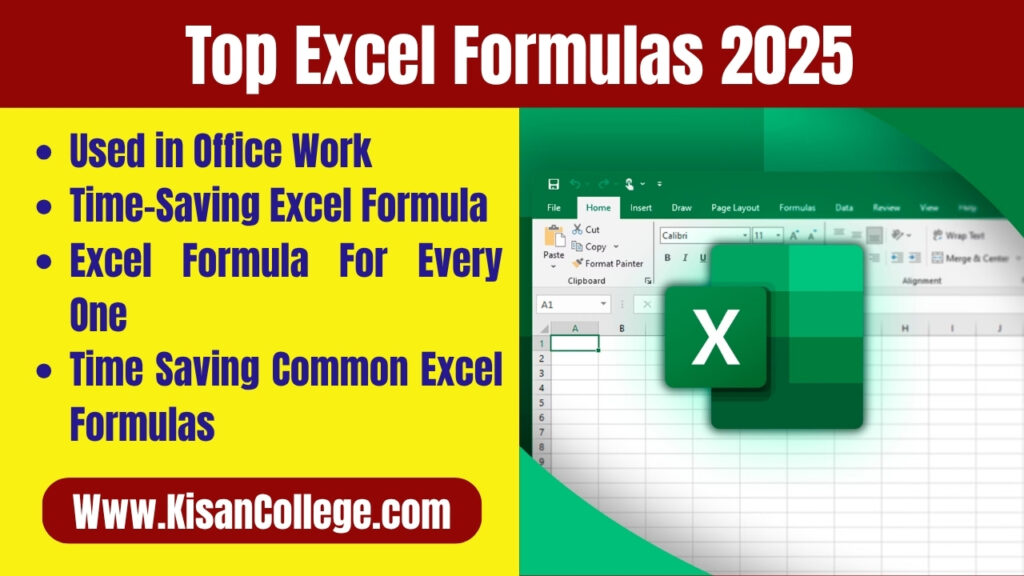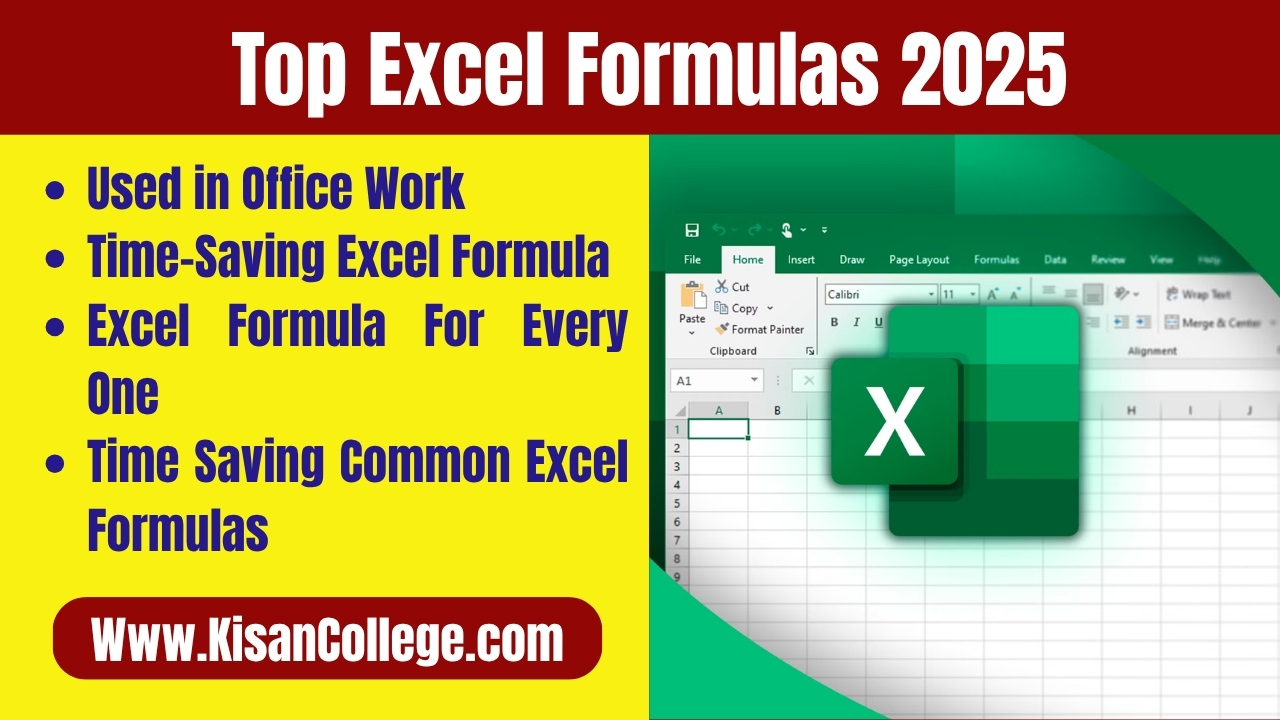Excel remains one of the most effective office tools in 2025. Excel facilitates data management, calculation, and organization whether you work in marketing, sales, human resources, or accounting. But you need to master the most practical formulas if you want to use Excel effectively.

The most popular Excel formulas for office work will be explained in this post. Each formula will be explained using examples in clear English. You will be able to use these formulas even if you are a beginner or student.
Contents
What is a Formula in Excel?
A formula in Excel is a small code that does a calculation. Every formula starts with an equal sign (=).
Example:=2+3 will give you 5.
You can also use cell references in formulas.
Example:
If A1 = 2 and A2 = 4, then=A1+A2 will return 6.
These basic formulas can be used to add, subtract, multiply, and divide numbers.
Top 10 Excel Formulas List for Office Work
Here is the list of most used Excel formulas that professionals use in office work daily:
| No. | Formula Name | Formula Syntax | Use |
|---|---|---|---|
| 1 | SUM | =SUM(A1:A5) | Adds numbers |
| 2 | AVERAGE | =AVERAGE(A1:A5) | Finds average |
| 3 | IF | =IF(A1>50,"Pass","Fail") | Conditional logic |
| 4 | VLOOKUP | =VLOOKUP(101, A2:D10, 2, FALSE) | Search a value |
| 5 | HLOOKUP | =HLOOKUP("Q1", A1:D5, 2, FALSE) | Search value horizontally |
| 6 | INDEX | =INDEX(A1:C3, 2, 1) | Get value by position |
| 7 | MATCH | =MATCH(200, A1:A5, 0) | Find position of value |
| 8 | LEN | =LEN(A1) | Count characters |
| 9 | TRIM | =TRIM(A1) | Remove extra spaces |
| 10 | CONCAT | =CONCAT(A1," ",B1) | Join text |
10 Time Saving Common Excel Formulas
Let’s now understand each formula with a short explanation.
1. SUM
Used to add values together.
Formula: =SUM(B2:D2)
Example: Add total Pokeballs: Pokeball(2) + Greatball(3) + Ultraball(1) = 6
2. IF
Used to check a condition.
Formula: =IF(A1>50, "Pass", "Fail")
If A1 is 60 → Result is “Pass”
3. AVERAGE
Calculates the average (mean).
Formula: =AVERAGE(A1:A5)
Useful in student marksheets or budget analysis.
4. COUNT and COUNTA
COUNT: Counts only numbers=COUNT(A1:A10)
COUNTA: Counts all non-empty cells=COUNTA(A1:A10)
5. COUNTIF
Counts how many cells match a condition.
Formula: =COUNTIF(A1:A10, ">100")
Helps in tracking sales over a target.
6. VLOOKUP
Search for a value in a table and return matching data.
Formula: =VLOOKUP(101, A2:D10, 2, FALSE)
Common in employee data or invoice tracking.
7. TEXT
Used to format numbers or dates.
Formula: =TEXT(A1, "dd-mm-yyyy")
Convert system date to readable format.
8. CONCAT (or CONCATENATE)
Join two or more text values.
Formula: =CONCAT(A1, " ", B1)
Useful in joining first and last names.
9. NOW and TODAY
=NOW() → Shows date & time=TODAY() → Shows only date
Good for reports and logs.
10. ROUND
Rounds a number to the required decimal places.
Formula: =ROUND(A1, 2)
If A1 = 3.4567 → result is 3.46
Excel Formulas Cheat Sheet 2025
| Purpose | Formula Example |
|---|---|
| Add values | =SUM(A1:A5) |
| Average | =AVERAGE(B1:B5) |
| Check condition | =IF(C1>60, "Yes", "No") |
| Search data | =VLOOKUP(ID, A2:D10, 2, FALSE) |
| Count items | =COUNT(A1:A10) |
| Combine text | =CONCAT(A1, " ", B1) |
Real-Life Use Case
Imagine you work in a toy company and want to count how many items each salesperson has.
| Name | Item A | Item B | Item C | Total |
|---|---|---|---|---|
| Iva | 2 | 3 | 1 | =SUM(B2:D2) → 6 |
| Liam | 4 | 5 | 3 | =SUM(B3:D3) → 12 |
| Adora | 5 | 6 | 4 | =SUM(B4:D4) → 15 |
Now total all in cell E5:=SUM(E2:E4) → Result: 33
Conclusion
Hours of manual labor can be avoided by using the appropriate formulas. This list of Excel formulae is your toolkit for more efficient Excel work. Use these formulas in your work whether you’re a student, teacher, or working professional.
You’ll get faster and more proficient with Excel as you practice more. For More Information Keep Visiting Www.KisanCollege.com
